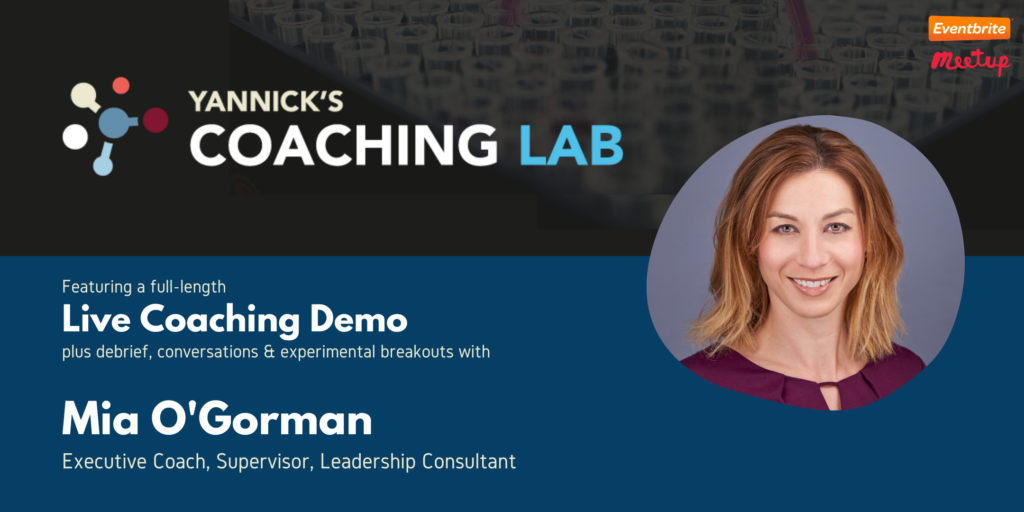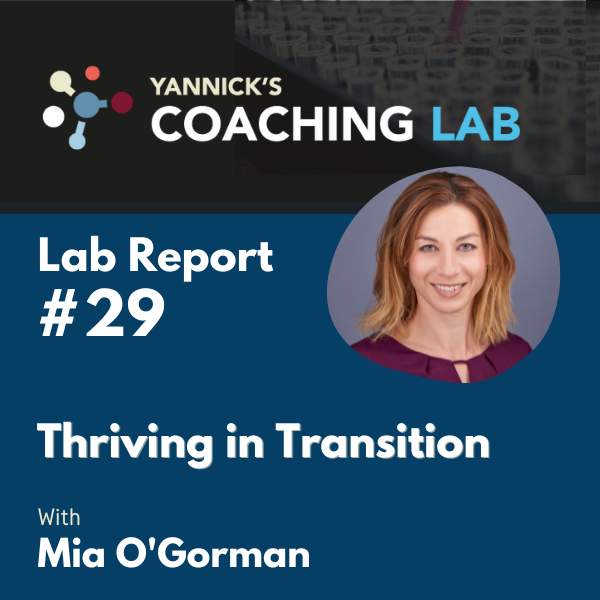
We’ve witnessed yet another insightful session with the wonderful Mia and her client who faced an important transition. What a privilege it was to sit in on this.
Curious to know more? Have a peek at this month’s Lab Report below or consider membership to access the recording of this and many more exciting coaching sessions (including a 45min debrief and Q&A with coach and client).
Yannick’s Coaching Lab #29 — Mia O’Gorman
Lab Report by Natalie Fraser
Context
Mia O’Gorman is a highly experienced coach, coach trainer, and coaching supervisor. Her work focuses mainly on leadership development within the corporate space and has undertaken significant transitions from her ‘rebellious’ entrance into the profession, to taking a very corporate stance, and further towards a place where the ‘humanness’ is prioritized.
Mia’s client has spent 35 years working in the theatre industry, and recently embarked on a coaching career alongside this. Her career in theatre is currently her main source of income, yet when her current theatre project comes to an end later this year, she plans to set up a coaching practice. Mia’s client would like to have support from her coach to better understand what this transition will look like, what she really wants, what will be most meaningful, and what she can give to the world with her remaining years.
Key Insights
Adaptable Contracting
Mia “jumped right in” rather than taking time to specifically contract at the start of the session. Mia explained that she starts her sessions asking, “what would you like to speak about today?”. Mia felt that the questions her client initially expressed sitting with called for a more freely exploratory and open-ended line of questioning. In contrast, had her client expressed specific goals Mia would have taken a more structured, agenda-based approach. Half-way through the session Mia offered the client to set more focused goals.
Mia later shared that in the corporate world, there is often an entire agenda building session, often between client, coach, and client’s line-manager/sponsor. Life coaching is more flexible in this regard.
Parts work “light” – One foot on the break, one on the accelerator
Mia identified that her client was speaking of herself in ‘parts’, such as the part of herself pushing her to undertake the MSc which she is currently struggling with. Mia invited her client to explore what other parts of herself were influencing, accelerating and/or breaking. This gave their client space to recognize both that there were more aspects of her than the part which is pushing herself to undertake something challenging, and to identify the roles that these different parts were playing.
This metaphor was revisited throughout the session, shedding light on how this way of being exists within multiple areas of her client’s life. Beyond this, this way of being was found to exist within her client’s nature. Upon observing this, Mia invited her client to reflect how these two (push/pull) parts within her would speak to each other. Her client was able to recognize the importance of these parts working together; of harmony. In the question time, Mia and her client both reflected that with less time constraints, their session could have benefited from using ‘chairwork’ techniques to allow these parts to converse more deeply.
Contextual Pressure
Mia explored what contextual pressure her client is under. This intervention gave Mia’s client the opportunity to consider her situation within the wider context, reflecting on the external realities and imagined experiences which may be impacting her dilemma. This led her client to arrive at two questions which Mia reflected back as important: “What am I imagining?” and “What am I hoping for?”
Personal Success Stories
Exploring the client’s impending challenge, Mia encouraged her to explore previous success stories of her own past achievements. Using her theatre career as an example, she recognized that passion and hard work and tenacity to do great work and be collaborative were at the heart of her success. Mia’s client did not clearly see an overlap between how these skills could apply to her coaching career, and further co-investigation revealed that this may be related to the nature of the outcome, such as the public (theatre) vs private (individual coaching).
Corporate or Creative
Mia picked up on her client mentioning and comparing earning potential between careers, and drew on her corporate approaches to support her client to investigate and identify the finances for each project. She noticed her client speaking in either/or tones, and reflected this back, providing insight into the potential to keep a more both/and approach. For example, explicitly suggesting that the financial role of each may fluctuate during the transition, and gave space for this to be accepted as a peaceful and natural part of a transition process.
Mid-session Reflection
Half way through the session, Mia created space for her client to pause and reflect on any stand-out reflections that may have come from the session so far. Mia reflected these back to her client, establishing that both she and her client were on the same page. Following this, she invited her client to take agency in the session role and choose the direction of the remainder of the session. This provided her client with the opportunity to either bring a new topic or (in this sessions’ case) return to a significant part of the discussion from the session thus far.
Mia expressed that especially in cases where sessions are infrequent, clients have a tendency to ‘explode’ with a lot of content at the beginning of the session. This pause invites them to take a breather, and choose which direction feels appropriate for the rest of the available session time.
Permission “when…”
Mia reflected a commonality between her client’s way of expressing her aspirations, drawing attention to the tendency to make statements that indicate she is only ‘permitted’ to achieve certain goals based on prerequisite achievements.
This led to Mia applying the intervention of transporting her client into these imagined future times, and by doing so her client recognized her priorities, basic needs (e.g. rest), and likely financial position at this time. Beyond this, Mia’s client was able to recognize the lack of guarantee of these imagined futures, and the presence of uncertainty.
Getting to the other side
Mia invited her client to question “what will help you get to the other side?” [meaning: the other side of her current projects towards where she is aspiring to go]. This enabled her client to break down the overwhelming ‘whole’ of her current tasks into a collection of smaller tasks. These tasks were then able to be organized in a logical order of engagement, and reduced the client’s sense of overwhelm. This was expressed by the client as a relieving experience. She expressed realizing “I’m in a shallow ditch, not an existential condition. I didn’t realize it was this shallow”.
Key Take-Aways
The client’s first reflection was that Mia had held a very calm, open, and practical space, which had been very helpful to reduce the overwhelm of the situation and understand practically how to proceed.
Mia’s client reflected that she had asked her “what would those two parts have to say to each other?” yet did not provide any formal coaching ‘structure’ to do this. The client’s conclusion was that these parts would need to work together. Mia expressed that the reason for lacking structure in this intervention was a sense that it was ‘too soon’ and the time limit of the 45 minute session. More structured interventions of dialogue between parts was identified as potentially valuable if there were future work together.
Mia expressed that feeling ‘calm and clear’ is the most common feedback that she gets from clients, and recognizes that this corresponds with her client’s feedback during this session. This is an important part of her coaching practice, inviting the audience to reflect on what environment they are creating in their own coaching relationships & the impact this may have on the session.
Participants reflected back that Mia has a wonderful way of holding space, and asked “how?” she does this in such a calm way. Mia expressed that this was one of the first things to come naturally, and isn’t sure that there is a specific “how” that could explain it, however curiosity and excitement were important attitudes to hold.
Watch the recording of this session and debrief by becoming a member: https://bit.ly/CoachingLabMembership
The complete vault of recordings can be found at https://bit.ly/LabRecordings
Many more exciting Labs are on the horizon: https://bit.ly/FutureCoachingLabs

